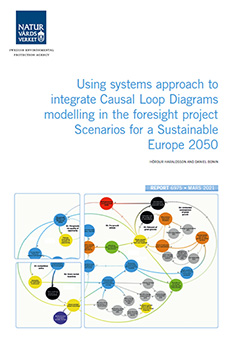Using systems approach to integrate Causal Loop Diagrams modelling in the foresight project Scenarios for a Sustainable Europe 2050
Om publikationen
The main purpose of this study was to showcase the use of Causal Loop Diagrams (CLD) analysis of the scenarios developed in the EIONET NRC FLIS project Scenariosfor a Sustainable Europe in 2050 (SSE 2050). This study attempts to abridging the foresight Scenario Method with the system dynamic qualitative approach using the Causal Loop Diagramming method. In the study, the four narratives (Ecotopia, A Pragmatic Path, Green Growth Paradigm, Utilitarian Technocracy for Good) from the SSE 2050 project were interpreted and contextualized to develop the CLDs. Combining the results of the Scenario Method from SSE 2050 with systems dynamics modelling was a special feature of this project.
The overall goal of the project was to 1) Show how scenario narratives can be illustrated using feedback loops and driving forces to show the evolution of different key factors over time. 2) Analyze and enhance the plausibility of each scenario as a function of time and improve the scenario consistency by enriching the scenarios.3) Show how systemic change can be facilitated in the normative scenarios being studied.
The results indicate that the solution scenarios produced from the SSE 2050 vary slightly in how the framing of system boundaries and the point of departure in the narratives are treated. Furthermore, the CLD can either be generic or specific in describing the scenario. All the solution scenarios required support factors to showbarriers/limitations to have the CLDs work in terms of appropriate reinforcing and balancing behaviour. The solution scenarios tended to highlight reinforcing behaviour in the narratives and omit the description of limiting factors, therefore showing unlimited growth. This illustrates the difference between the Scenario Method and the CLD approach.
One of the conclusions from the study points toward the necessity to be explicitin the description of the solution scenarios (and its supporting projection description) since the factors derived for the CLDs need explicit language. This will aid in enriching and identifying key factors of influence in the scenarios, and furthermore validating and preparing the results for further communication is the next step. The study shows that scenario CLDs can be a point of departure to enrich the scenarios further and complement a foresight process.
